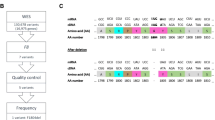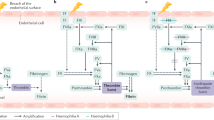Abstract
The differential diagnosis of the genetic bleeding disorders, hemophilia A and von Willebrand disease, is occasionally confounded by the close molecular relationship of coagulation factor VIII and von Willebrand factor (vWF). This report describes the autosomal inheritance of a hemophilia A phenotype due to a mutation of vWF that results in defective factor VIII binding. The proband was a female patient with low levels of factor VIII activity. Polymerase chain reaction (PCR) amplification and DNA sequencing were employed to examine exons encoding the putative factor VIII binding domain of vWF. The patient was found to be homozygous for a single point mutation causing a Thr→Met substitution at amino acid position 28 in the mature vWF subunit. The phenotypic expression of the mutation was determined to be recessive because heterozygous family members were clinically unaffected. Recombinant vWF containing the observed amino acid substitution was expressed in COS-1 cells. The mutant vWF was processed and secreted normally, and was functionally equivalent to wild-type vWF in its abiltiy to bind to platelets. However, the mutant failed to bind factor VIII, demonstrating that the mutation was functionally related to the observed hemophilia phenotype. The family we describe demonstrates the recessive inheritance of a recently recognized class of genetic bleeding disorders, we call “autosomal hemophilia.” We conclude that vWF mutation may be an under recognized cause of hemophilia, especially in cases where the inheritance pattern is not consistent with X-linked transmission.
Similar content being viewed by others
References
Bahou WF, Ginsburg D, Sikkink R, Litwiller R, Fass DN (1989) A monoclonal antibody to von Willebrand factor (vWF) inhibits factor VIII binding. J Clin Invest 84: 56–61
Bonthron DT, Handin RI, Kaufman RJ, Wasley LC, Orr EC, Mitsock LM, Ewenstein B, Loscalzo J, Ginsburg D, Orkin SH (1986a) Structure of pre-pro-von Willebrand factor and its expression in heterologous cells. Nature 324: 270–273
Bonthron DT, Orr EC, Mitsock LM, Ginsburg D, Handin RI, Orkin SH (1986b) Nucleotide sequence of pre-pro-von Willebrand factor cDNA. Nucleic Acids Res 14: 17125–7127
Brinkhous KM, Sandberg H, Garris JB, Mattsson C, Palm M, Griggs T, Read MS (1985) Purified human factor VIII procoagulant protein: comparative hemostasis response after infusions into hemophilic and von Willebrand disease dogs. Proc Natl Acad Sci USA 82: 8752–8756
Cacheris PM, Nichols WC, Ginsburg D (1991) Molecular characterization of a unique von Willebrand disease variant: a novel mutation affecting von Willebrand factor/factor VIII interaction. J Biol Chem 266: 13499–13502
Fay PJ, Coumans J-V, Walker FJ (1991) von Willebrand factor mediates protection of factor VIII from activated protein C-catalyzed inactivation. J Biol Chem 266: 2172–2177
Foster PA, Fulcher CA, Marti T, Titani K, Zimmerman TS (1987) A major factor VIII binding domain resides within the aminoterminal 272 amino acid residues of von Willebrand factor. J Biol Chem 262: 8443–8446
Gaucher C, Jorieux S, Mercier B, Oufkir D, Mazurier C (1991a) The “Normandy” variant of von Willebrand disease: characterization of a point mutation in the von Willebrand factor gene. Blood 77: 1937–1941
Gaucher C, Mercier B, Jorieux S, Oufkir D, Mazurier C (1991b) Identification of two point mutations in the von Willebrand factor gene of three families with the ‘Normandy’ variant of von Willebrand disease. Br J Haematol 78: 506–514
Graham JB, Barrow ES, Roberts HR, Webster WP, Blatt PM, Buchanan P, Cederbaum AI, Allain JP, Barrett DA, Gralnick HR (1975) Dominant inheritance of hemophilia A in three generations of women. Blood 46: 175–188
Hill-Eubanks DC, Lollar P (1990) von Willebrand factor is a cofactor for thrombin-catalyzed cleavage of the factor VIII light chain. J Biol Chem 265: 17854–17858
Kaufman RJ, Wasley LC, Dorner AJ (1988) Synthesis, processing and secretion of recombinant human factor VIII expressed in mammalian cells. J Biol Chem 263: 6352–6362
Koedam JA, Meijers JCM, Sixma JJ, Bouma BN (1988) Inactivation of human factor VIII by activated protein C. Cofactor activity of protein S and protective effect of von Willebrand factor. J Clin Invest 82: 1236–1243
Kroner PA, Friedman KD, Fahs SA, Scott JP, Montgomery RR (1991) Abnormal binding of factor VIII is linked with the substitution of glutamine for arginine 91 in von Willebrand factor in a varianct form of von Willebrand disease. J Biol Chem 266: 19146–19149
Mancuso DJ, Tuley EA, Westfield LA, Worral NK, Shelton-Inloes BB, Sorace JM, Alevy TG, Sadler JE (1989) Structure of the gene for human von Willebrand factor. J Biol Chem 264: 19514–19527
Mazurier C, Jorieux DS, Delobel J, Goudemand M (1990a) A new von Willebrand (vWF) defect in a patient with factor VIII (FVIII) deficiency but with normal levels and multimeric patterns of both plasma and platelet vWF: characterization of abnormal vWF/FVIII interaction. Blood 75: 20–26
Mazurier C, Gaucher C, Jorieux S, Parquet-Gernez A, Goudemand M (1990b) Evidence for a von Willebrand factor defect in factor VIII binding in three members of a family previously misdiagnosed mild hemophilia A and hemophilia A carriers: consequences for therapy and genetic functional sites. Br J Haematol 76: 372–379
Mohri H, Yoshika A, Zimmerman TS, Ruggeri ZM (1989) Isolation of the von Willebrand factor domain interacting with platelet glycoprotein Ib, heparin, and collagen and characterization of its three distinct functional sites. J Biol Chem 264: 17361–17367
Montgomery RR, Hathaway WE, Johnson J, Jacobson L, Muntean W (1982) A variant of von Willebrand's disease with abnormal expression of factor VIII procoagulant activity. Blood 60: 201–207
Nishino M, Girma J-P, Rothschild C, Fressinaud E, Meyer D (1989) New variant of von Willebrand disease with defective binding to factor VIII. Blood 74: 1591–1599
Peake IR, Bowen D, Bignell P, Liddell MB, Sadler JE, Standen G, Bloom AL (1990) Family studies and prenatal diagnosis in severe von Willebrand disease by polymerase chain reaction amplification of a variable number tandom repeat region of the von Willebrand factor gene. Blood 76: 555–561
Peerlinck K, Eikenboom JCJ, Ploos van Amstel HK, Sangtwaesin W, Arnout JA, Reitsma PH, Vermylen J, Briet E (1992) A patient with von Willebrand's disease characterized by a compound heterozygosity for a substitution of Arg854 by Gln in the putative factor VIII-binding domain of von Willebrand factor (vWF) on one allele and very low levels of mRNA from the second vWF allele. Br J Haemotol 80: 358–363
Sadler JE (1989) von Willebrand disease. In: Beaudet AI, Sly WS, Valle D (eds) The metabolic basis of inherited diseases. Mc-Graw-Hill, New York, pp 2171–2188
Sambrook J, Fritch EF, Maniatis T (1989) Molecular cloning: a laboratory manual, 2nd edn. Cold Spring Harbor Laboratory, Cold Spring Harbor, NY
Simone JV, Vanderheiden J, Abildgaard CF (1967) A semiautoatic one-stage factor assay with a commercially prepared standard. J Lab Clin Med 69: 706–712
Takahashi Y, Kalafatis M, Girma J-P, Sewerin K, Andersson L-O, Meyer D (1987) Localization of factor VIII binding domain on a 34 kilodalton fragment of the N-terminal portion of von Willebrand factor. Blood 70: 1679–1682
Tuddenham EGD, Lane RS, Rotblat F, Johnson AJ, Snape TJ, Middleton S, Kernoff PBA (1982) Response to infusions of polyelectrolyte fractionated human factor VIII concentrate in human hemophilia A and von Willebrand disease. Br J Haematol 52: 259–267
Tuley EA, Gaucher C, Jorieux S, Worrall NK, Sadler JE, Mazurier C (1991) Expression of von Willebrand factor “Normandy,” an autosomal mutation that mimics hemophilia A. Proc Natl Acad Sci USA 88: 6377–6381
Weiss HJ, Sussman II, Hoyer LW (1977) Stabilization of factor VIII in plasma by the von Willebrand factor. J Clin Invest 60: 390–404
Wise RJ, Pittman DD, Handin RI, Kaufman RJ, Orkin SH (1988) The propeptide of von Willebrand factor independently mediates the assembly of von Willebrand factor multimers. Cell 52: 229–236
Wise RJ, Dorner AD, Krane M, Pittman DD, Kaufman RJ (1991) The role of von Willebrand factor multimers and propeptide cleavage in binding and stabilization of factor VIII. J Biol Chem 266: 21948–21955
Author information
Authors and Affiliations
Rights and permissions
About this article
Cite this article
Wise, R.J., Ewenstein, B.M., Gorlin, J. et al. Autosomal recessive transmission of hemophilia A due to a von Willebrand factor mutation. Hum Genet 91, 367–372 (1993). https://doi.org/10.1007/BF00217358
Received:
Issue Date:
DOI: https://doi.org/10.1007/BF00217358




